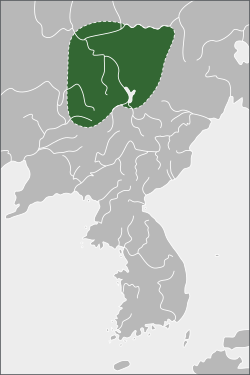Buyeo | |||||||||||
|---|---|---|---|---|---|---|---|---|---|---|---|
| c. 2nd century BC–494 AD | |||||||||||
 Map of Buyeo (3rd century) | |||||||||||
| Capital | Buyeo | ||||||||||
| Common languages | Buyeo, Classical Chinese (literary) | ||||||||||
| Religion | Buddhism, Shamanism | ||||||||||
| Government | Monarchy | ||||||||||
| King | |||||||||||
• ?–? | Hae Mo-su? | ||||||||||
• 86 – 48 BC | Buru | ||||||||||
• ? – 494 AD | Jan (孱) (last) | ||||||||||
| Historical era | Ancient | ||||||||||
• Established | c. 2nd century BC | ||||||||||
• Disestablished | 494 AD | ||||||||||
| |||||||||||
| Today part of | China | ||||||||||
| Buyeo | |||||||
|---|---|---|---|---|---|---|---|
| Chinese name | |||||||
| Traditional Chinese | 夫餘 | ||||||
| Simplified Chinese | 夫余 | ||||||
| |||||||
| Korean name | |||||||
| Hangul | 부여 | ||||||
| Hanja | 夫餘 | ||||||
| |||||||
| History of Manchuria |
|---|
 |
| History of Korea |
|---|
 |
| Timeline |
|
|
Buyeo[1] (Korean: 부여; Korean pronunciation: [pu.jʌ]; Chinese: 夫餘/扶餘; pinyin: Fūyú/Fúyú), also rendered as Puyŏ[2][3] or Fuyu,[1][3][4][5] was an ancient kingdom that was centered in northern Manchuria in modern-day northeast China. It had ties to the Yemaek people, who are considered to be the ancestors of modern Koreans.[6][7][8] Buyeo is considered a major predecessor of the Korean kingdoms of Goguryeo and Baekje.
According to the Book of the Later Han, Buyeo was initially placed under the jurisdiction of the Xuantu Commandery,[9] one of Four Commanderies of Han in the later Western Han. Buyeo entered into formal diplomatic relations with the Eastern Han dynasty by the mid-1st century AD as an important ally of that empire to check the Xianbei and Goguryeo threats. Jurisdiction of Buyeo was then placed under the Liaodong Commandery of the Eastern Han.[10] After an incapacitating Xianbei invasion in 285, Buyeo was restored with help from the Jin dynasty. This, however, marked the beginning of a period of decline. A second Xianbei invasion in 346 finally destroyed the state excepting remnants in its core region; these survived as vassals of Goguryeo until their final annexation in 494.[11]
Inhabitants of Buyeo included the Yemaek tribe.[12][13] There are no scholarly consensus on the classification of the languages spoken by the Puyo, with theories including Japonic,[14] Amuric[15] and a separate branch of macro-Tungusic.[16] According to the Records of the Three Kingdoms, the Buyeo language was similar to those of Goguryeo and Ye, and the language of Okjeo was only slightly different from them.[17] Both Goguryeo and Baekje, two of the Three Kingdoms of Korea, considered themselves Buyeo's successors.[18][19][20]
- ^ a b Escher, Julia (2021). "Müller Shing / Thomas O. Höllmann / Sonja Filip: Early Medieval North China: Archaeological and Textual Evidence". Asiatische Studien - Études Asiatiques. 74 (3): 743–752. doi:10.1515/asia-2021-0004. S2CID 233235889.
- ^ Byington 2016.
- ^ a b Pak, Yangjin (1999). "Contested ethnicities and ancient homelands in northeast Chinese archaeology: the case of Koguryo and Puyo archaeology". Antiquity. 73 (281): 613–618. doi:10.1017/S0003598X00065182. S2CID 161205510.
- ^ Smallwood, Colonel (1931). "Manchuria and Mongolia: Glimpses at both". Journal of the Royal Central Asian Society. 19 (1): 101–120. doi:10.1080/03068373208725190.
- ^ Beardsley, Richard K.; Smith, Robert J., eds. (1962). Japanese Culture Its Development and Characteristics. Routledge. pp. 12–16. ISBN 9780415869270.
- ^ Byington 2016, pp. 20–30.
- ^ Barnes, Gina (2015). State Formation in Korea: Emerging Elites. UK: Routledge. pp. 26–33. ISBN 9781138862449.
- ^ Jo, Yeongkwang (2015). "The Origin and Meaning of the Naming of Yemaek, Buyeo, Goguryo". Ancient Korean History Society. 44: 101–122.
- ^ "夫餘本屬玄菟", Dongyi, Fuyu chapter of the Book of the Later Han
- ^ "獻帝時, 其王求屬遼東云", Dongyi, Fuyu chapter of the Book of the Later Han
- ^ La Universidad de Seúl, 《Seoul Journal of Korean Studies,》, Vol.17, 2004. p.16
- ^ 노태돈 (1995). 부여(夫餘) [Buyeo]. Encyclopedia of Korean Culture (in Korean). Retrieved 2021-09-16.
- ^ 노태돈; 김선주 (2009) [1995]. 예맥(濊貊) [Yemaek]. Encyclopedia of Korean Culture (in Korean). Retrieved 2021-09-16.
- ^ Beckwith, C.I. (2007). "The ethnolinguistic history of Koguryo". Koguryo: The Language of Japan's Continental Relatives. Brill. pp. 29–49.
- ^ Janhunen, Juha (2005). "The lost languages of Koguryo" (PDF). Journal of Inner and East Asian Studies. 2 (2).
- ^ Unger, J Marshall (2001). "Layers of Words and Volcanic Ash in Japan and Korea". The Journal of Japanese Studies. 27 (1): 81–111. doi:10.2307/3591937. JSTOR 3591937.
- ^ Lee & Ramsey 2011, p. 34.
- ^ Lee, Hee Seong (2020). "Renaming of the State of King Seong in Baekjae and His Political Intention". 한국고대사탐구학회. 34: 413–466.
- ^ Park, Gi-bum (2011). "The Lineage and Establishment of the Foundation Myths of Buyeo and Koguryo : An Analysis of "Kogi" Cited in "Northern Buyeo Articles" in Samguk yusa". 동북아역사재단. 34: 205–244.
- ^ Jo, Yeong-gwang (2017). "About the origin of the Buyeo clan of Baekje monarchy". Korea Ancient History Society. 53: 169–194.